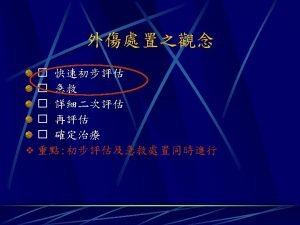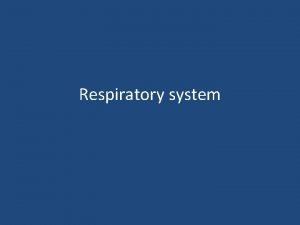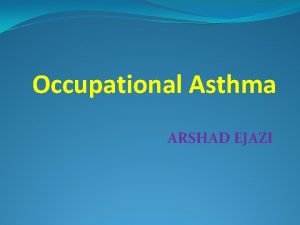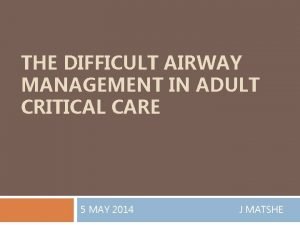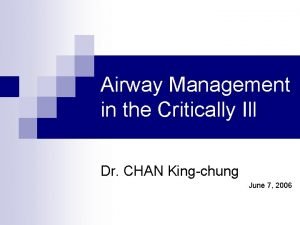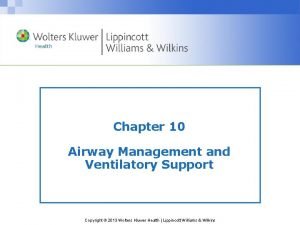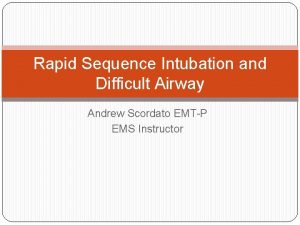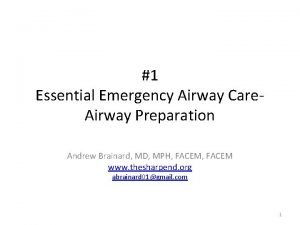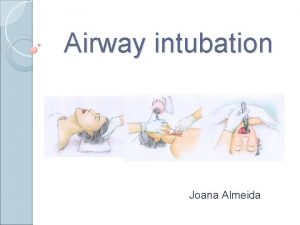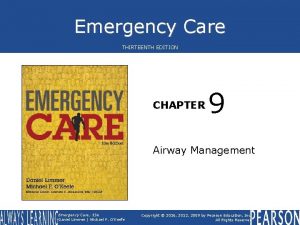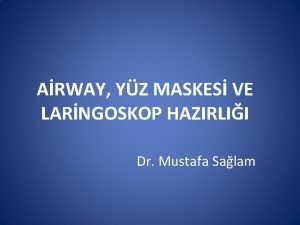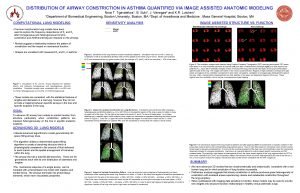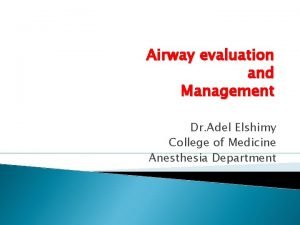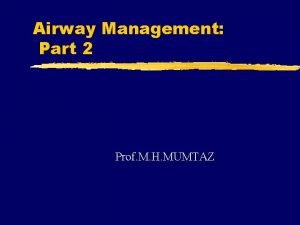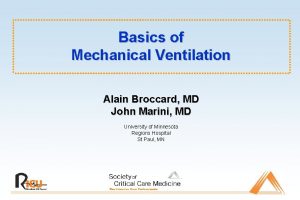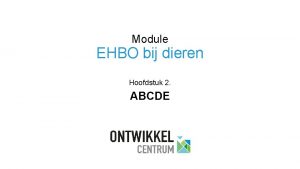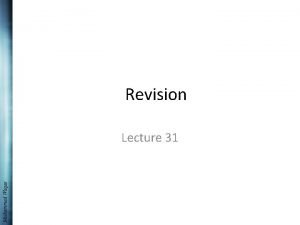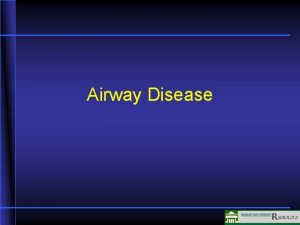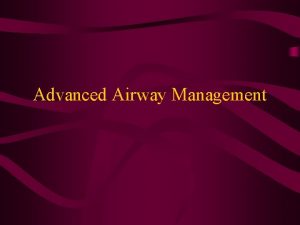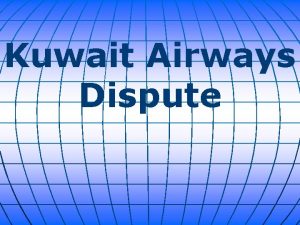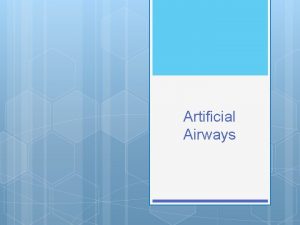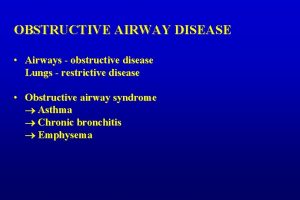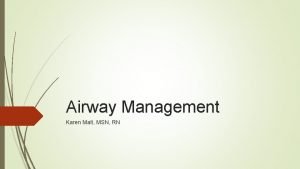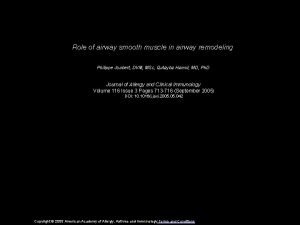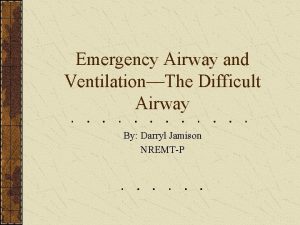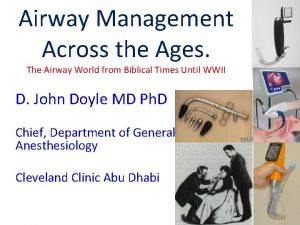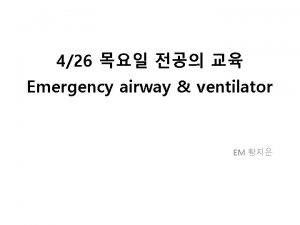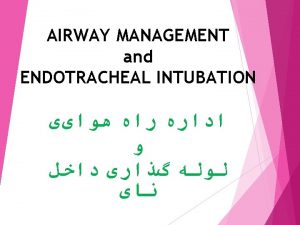Managing The Airways Dr Waqas Airway Status Airway









































































- Slides: 73

Managing The Airways Dr. Waqas

Airway Status �Airway patency is a term used to describe the status of the airway. �An open and clear airway is called patent, whereas an obstructed airway is compromised.

Anatomy of airways �The upper airway is composed of the oropharynx and nasopharynx �The oropharynx starts at the mouth and ends at the trachea �The mouth includes the tongue inferiorly and the hard palate superiorly. The tongue has many functions, but for our purposes it is only a problem.

Lower Airways �The lower airway consists of the epiglottis and the larynx. The epiglottis is a flap that covers the opening to the trachea (the glottis) when food or fluid passes into the esophagus. The larynx is composed of nine cartilages and muscles and is located anterior to the fourth, fifth, and sixth cervical vertebrae in adults. The larynx is also known as the Adam’s apple. It is a dynamic structure and protects the glottis while also allowing phonation.

�The tongue is the most common reason for airway obstruction because in the supine unconscious athlete it can slide backward and occlude the passage of air into the trachea �This situation is commonly described as the tongue being “swallowed, ” although swallowing the tongue is not actually possible.

Sign of obstructed airways �Signs of an obstructed airway include snoring respirations, sternal and intercostal retractions, accessory muscle use, and gurgling. �Snoring respirations are common and indicate that the tongue is partially occluding the airway.

� A smooth and symmetrical expansion of the thorax indicates a normal respiratory effort. � The condition in which the upper sternum sinks inward while the remainder of the sternum expands outward is called sternal retractions and very little air is exchanged with each breath. � Intercostal retractions and accessory muscle use mostly describe difficulty breathing frequently seen with acute asthma attacks and may or may not be related to airway obstruction. � Intercostal retractions are seen by examining the chest wall and looking at the muscles between the ribs. � If the muscles sink inward while the chest is expanding outward for inhalation, retractions are present. � Accessory muscle use describes the contraction of the sternocleidomastoid muscles of the neck to aid in expansion of the chest for inhalation. � Gurgling always indicates fluid in the airway typically either saliva or vomitus.

�Clearing an obstructed airway usually requires repositioning the head, jaw, and neck

�The head tilt–chin lift technique (Fig. 3 -2) will almost always result in a patent airway; However, this technique cannot be used in the unconscious athlete who is assumed to have a cervical spine injury. � Therefore, the jaw thrust, or triple airway, manoeuvre is more appropriate for an athlete who is unconscious.

Head tilt–chin lift method

Jaw thrust manoeuvre


Airway Adjuncts �The oropharyngeal (OP) and nasopharyngeal (NP) airways are used to relieve an obstructed airway after the initial jaw thrust maneuver has shown its effectiveness. �The adult OP airway comes in small, medium, and large sizes �Proper sizing is made by holding the airway along the cheek. It should stretch from the tip of the ear to the corner of the mouth


Oropharyngeal Airway �Inserting the OP airway requires stabilizing the tongue with a tongue depressor and sliding the airway into the posterior oropharynx following the natural curve of the airway. �The OP airway is inserted with the curve toward the hard palate until the tip is beyond the middle of the tongue. �The airway is then rotated into its natural position with the tip downward and into the posterior pharynx.

Oropharyngeal Airway


Contraindication �This technique is contraindicated in the �Paediatric population. �An intact gag reflex as indicated by biting is a contraindication to placement of an OP airway. �Complications of insertion include damage to the teeth and hard palate and worsening of the airway obstruction if not positioned properly

Nasopharyngeal Airway �The NP airway is made of soft rubber and comes in sizes small, medium, and large. Soft plastic or rubber tube that is designed to pass just inferior to the base of the tongue �Passed through one of the nares and can be used in patients with an intact gag reflex. �Nonlatex airways are also manufactured and are firmer than the rubber airways. An alternative sizing scale is 28, 30, 32, and 34 French.


Nasopharyngeal Airway The diameter of the airway should approximate the size of the nares. The flange on the airway prevents losing the entire airway in the nose and is adjusted for length based on sizing. The airway is lubricated with a water soluble gel and inserted with the bevel toward the septum and inferiorly in the left nostril. If resistance is met, the airway should be withdrawn and reinserted at a new angle.

If still unable to pass the airway, withdraw and use the right nostril. When using the right side, the airway is inserted upside down so the bevel is aligned with the septum. Once approximately half the airway is into the nostril, rotate into its natural position.

Contraindications • CONTRAINDICATED in cases of suspected or possible • Basilar skull fracture • Facial trauma • Epistaxis


Oxygen Therapy Airway management is not complete without the administration of supplemental oxygen. Athletic trainers need to check the scope of practice defined by their state licensure acts, but short-term oxygen administration is not contraindicated in an emergency situation. Involvement of the team physician in the decision to provide oxygen therapy may resolve any conflicts.

Oxygen administration by an athletic trainer may be restricted by state law. Oxygen is supplied in either steel or aluminum tanks of varying sizes, which are painted green. Aluminum tanks are superior to steel because they are lighter and will not rust. Although oxygen tanks come in various sizes, all are pressurized to 2000 psi when full. The most common-sized tanks used in the prehospital arena are D and E tanks.

Oxygen Therapy �A D tank is 20 inches in length and holds 360 L of oxygen, whereas an E tank is 30 inches in length and holds 625 L of oxygen �A regulator is attached to the top of the tank and has three parts: �Pressure gauge, �Pressure-reducing valve, �Flow meter

The gauge shows the pressure in the tank (2000 psi is a full tank), Valve reduces the pressure to a usable flow, Meter sets the oxygen flow rate. Psi=Pound per square inch=pressure measure

Therefore, a D tank set at 10 L/min will last 36 minutes when the tank is full, whereas an E tank will last 62. 5 minutes. Oxygen tanks must be stored carefully and should always be in a holder and never left standing upright. If the regulator is knocked off, the sudden release of highly pressurized oxygen will cause the tank to fly through the air like a deadly missile

Although oxygen is not flammable, it does support combustion and should never be used near an open flame. Smoking in the area of oxygen administration is contraindicated and dangerous. Patients with chronic obstructive pulmonary disease (COPD) deserve special mention. COPD includes emphysema, bronchitis, asthma, and black lung disease. Oxygen administration over a long period (hours) may lead to hypoventilation or even apnea.

For this reason there is a common misconception among health care providers that patients with COPD should never receive oxygen by any means other than a nasal cannula at low flow rates. High-flow oxygen to any patient with difficulty breathing in an emergency situation is recommended no matter what past medical history exists. It should be noted that the incidence of COPD in a young athletic population is almost always asthma.

Nasal cannula Oxygen is administered by a variety of devices. Each of these devices delivers a set amount of oxygen to the patient, referred to as the fraction of inspired oxygen (Fi. O 2) A nasal cannula has two prongs that are inserted in the nose and held in place by tubing wrapped around the ears. A nasal cannula can administer from 1 to 6 L/m of oxygen, which gives a Fi. O 2 of 25% to 40%. Flow rates of 5– 6 L/m are uncomfortable and, unless humidified, will dry the nasal passages and lead to nose bleeds. Oxygen by nasal cannula is only utilized with conscious and stable patients.



Simple face mask , Reservoir bag face mask A simple face mask will deliver a Fi. O 2 of 40% to 60% at 6 to 10 L/m, whereas a reservoir bag face mask will deliver 60% to 90% at 10 to 15 L/m. The reservoir bag face mask (also referred to as a partial non breather mask) is preferred for patients who are unconscious or unstable. Although it is common for emergency medical technicians (EMT) to use 15 L/m with either type of face mask, the clinical difference in Fi. O 2 between 10 and 15 L/m is insignificant and will only drain the tank one third faster. This is an important consideration if using a D tank

The reservoir bag oxygen mask delivers the highest concentration of oxygen and should be used for the unconscious athlete with adequate respiratory effort.

Bag valve mask (BVM) The bag valve mask (BVM) is used to either assist the breathing or ventilate a patient with apnea. An adult BVM has a capacity of approximately 1600 cc and uses a mask to maintain a seal around the face. When connected to an oxygen source and using a reservoir bag, The BVM will deliver a Fi. O 2 of nearly 100%. The flow rate should be sufficient to fill the bag with each ventilation or 10 to 15 L/m.

�The bag valve mask is used to assist respirations in the unconscious athlete with inadequate respirations

BVM The BVM may also be connected to an endotracheal tube if the patient is intubated. All artificial breathing tubes (endotracheal, laryngeal mask airway [LMA] , combitube, and King laryngeal tube-disposable [King LT-D]) have the same 15 mm connector for the BVM. Ventilating a patient with a BVM mask is a difficult skill to master, and practice on a regular basis with a mannequin is strongly encouraged. Using the E-C technique described later in the text is important to obtain a good seal around the mouth and nose to deliver effective tidal volumes to the patient.

E-C Technique Using your left hand, place your thumb and index finger on the mask, forming a C. Then place your small, ring, and middle fingers along the mandible with your small finger at the corner of the jaw. These three fingers should form an E. Lift up on the jaw with the E and pull the mouth and nose up into the mask. Squeeze the bag with your right hand see the effectiveness of your ventilations by how high the chest rises. Good chest expansion is crucial for effective BVM mask ventilation.

Shaping your fingers into an E and C formation allows for effective mask ventilation with a BVM.

If air leaks around the mask, either reposition your hands or use your right hand to seal the patient’s right cheek with the mask. If using both hands to obtain a good mask seal, you will need a second person to squeeze the bag. Novices are encouraged to use a two-person technique when performing BVM mask ventilation. Ventilate the patient at 10 breaths per minute. It is almost always necessary to use either an NP or OP airway when bagging a patient.

Pocket mask A CPR pocket mask may also be used in ventilating a patient. This simple device has the same type of mask used with a BVM along with a one-way valve. Ventilations are provided by the athletic trainer through mouth-to-mask ventilation. The mask is sealed in the same manner as the BVM mask. Unless equipped with a supplemental oxygen port, the pocket mask delivers less than room air Fi. O 2 (21%). The pocket mask is convenient to carry and is better than mouth-to-mouth rescue breathing but is not a good substitute for a BVM and oxygen.

The pocket mask is a safer and more effective alternative to mouth-tomouth respirations.

Fi. O 2 and Flow Rates for Various Device Fi. O 2(%) Flow Rate Nasal cannula 25– 40 1– 6 Simple face mask 40 -60 6 -10 Reservoir bag face mask 60– 90 10– 15 BVM 100 10 -15


Advanced Airway Devices Although effective ventilation with a BVM is possible for a short time, eventually the airway must be secured by an advanced airway device. This may occur before or after arrival at the hospital, and the gold standard has always been endotracheal intubation. This technique involves using a laryngoscope to directly visualize the vocal cords at the glottic opening and passing a cuffed endotracheal tube into the trachea. Once the tube is properly placed and the cuff is inflated, the trachea is sealed and gastric aspiration is unlikely.


This skill is reserved for physicians, nurse anesthetists, paramedics, and occasionally respiratory therapists and EMT-Intermediates and requires significant training and frequency to maintain proficiency. It has recently been suggested that paramedics do not perform the skill often enough to maintain a reasonable level of Proficiency Intubation is not within the athletic trainer’s scope of practice, but they should be familiar with the technique.

Large sports medicine staffs should consider having at least one person available who has the training and legal status to perform advanced airway techniques. Other devices used to secure an airway require less training and frequency of use to maintain proficiency. State laws may or may not allow athletic trainers to use these devices.

Laryngeal Mask Airway The LMA was developed in Great Britain in the late 1980 s and is often used in operating rooms for minor surgical cases requiring general anesthesia. The LMA comes in eight sizes based on weight , including pediatric. It is blindly inserted into the posterior oropharynx, and the cuff is inflated with 10 to 30 cc of air, creating a seal around the glottic opening. A BVM is attached and the patient is ventilated.


Has a drain tube to aid in gastric suctioning. The LMA does not prevent aspiration of gastric contents and the seal may be lost when moving the patient. Disposable LMAs are low cost and are frequently used as a backup to a failed intubation within the hospital. LMA use by paramedics uncommon in the United States

The LMA is a super-glottic airway that does not protect against gastric aspiration. B: The LMA in place over the glottic opening


Combitube This is a multi-lumen airway that works whether it is inserted into the esophagus or the trachea. It either blocks the esophagus above and below the glottic opening or by directly ventilating the trachea. The combitube is a double lumen tube that is blindly inserted into the esophagus.

Combitube There are two balloons, each with an inflation port. The distal balloon is inflated with 15 cc of air and seals the esophagus. The proximal balloon is inflated with 60 cc of air and seals the oropharynx. Lumen 1 is closed at the tip but has holes between the balloons that allow air to enter the trachea. Lumen 2 is open at the tip but not between the balloons. After insertion, the BVM is attached to lumen 1 and the patient is ventilated

Combitube If properly positioned, the chest will rise and breath sounds will be heard by auscultation with a stethoscope. Rarely, the combitube may enter the trachea, in which case lumen 2 is used to ventilate the patient. The combitube provides some protection against gastric aspiration and is disposable. Although the combitube may be used as a primary airway device, it is most often used as a backup to a failed intubation. The combitube comes in two sizes based on height and is significantly more expensive than the disposable LMA.

Contraindicated in patients under 5 foot tall or those under 14 years old, in patients who have ingested caustic substances, patients with esophageal trauma or disease, and in patients with an intact gag reflex


B: Combitube is designed to be placed into the esophagus. C: On rare occasions the combitube may enter the trachea, in which case it functions as an endotracheal tube

King LT-D The King laryngeal tube-disposable is a new device introduced into the United States from Germany in 2005. It resembles the combitube but has only one lumen and its two balloons are filled from one inflation port. The King LT-D is inserted blindly into the esophagus. The distal balloon is inflated, which seals the esophagus; the proximal balloon seals the oropharynx. There are three sizes based on height, and the amount of air used to inflate the balloons varies by size (45– 90 cc).

King LT-D The King LT-D cannot be used for patients who are shorter than 4 feet tall. Pediatric sizes are under development. The area between the balloons is open and air will enter the trachea when the BVM is attached. The King LT-D provides some protection against gastric aspiration and is only slightly more expensive than the disposable LMA.

The King airway is a super-glottic airway that offers some protection against gastric aspiration and is easy to insert.

Suction The risk of vomiting exists during the management of any airway crisis, especially when advanced airway devices or a BVM are used. Aspiration of vomitus into the lungs may cause aspiration pneumonitis, which is a serious and sometimes fatal complication. Athletes are assumed to have a full stomach because they are consuming fluids during practice and competition; therefore, the risk of vomiting is high when the airway is compromised.

Suction Various types of portable suction equipment are available, ranging from manual to electronic. Electronic suction units are superior to manual units but are more expensive and require a battery charging system. These electronic units use a large bore yankauer suction catheter to remove vomitus Suctioning should be limited to less than 20 seconds because all oxygen is removed from the airway during the procedure. Care must also be taken so that the athlete does not bite down on the yankauer catheter. The effectiveness of manual units is suspect.

Suction If suction equipment is not available, the athlete may be turned on his or her side while maintaining the cervical spine in a neutral position and the vomitus cleared manually with a towel. Prior to their arrival, EMS personnel should be advised that the athlete has vomited so that they may have their portable suction unit readily available. Early recognition an intervention are crucial when dealing with a compromised airway. A variety of advanced techniques and equipment is available to aid in airway Management.

Suction Athletic trainers must know and adhere to the scope of practice for their state and never exceed this scope. Additional training and certification may be necessary to use many of the techniques and equipment. It is recommended that students and staff regularly practice on a mannequin all of the techniques available to them.

An electronic portable suction unit will clear the airway of large particulate matter but requires maintenance and regular battery charging.

A portable manual suction unit is less effective than an electronic unit but requires no maintenance.



Types of intubation Endoctracheal intubation- the passage of a tube through the nose or mouth into the trachea for maintenance of the airway during anesthesia or for maintenance of an impaired airway. Nasogastric intubation- the insertion of an endotracheal tube through the nose and into the stomach. Nasotracheal intubation- the insertion of an endotracheal tube through the nose and into the trachea. without hyperextension, therefore it is useful insertion of an endotracheal tube.
 Epiglottic
Epiglottic Definitive airways
Definitive airways Jetblue ipo price
Jetblue ipo price Kalahari airways
Kalahari airways Upper respiratory tract organs
Upper respiratory tract organs Conducting airways
Conducting airways Dr arshad ejazi
Dr arshad ejazi Một số thể thơ truyền thống
Một số thể thơ truyền thống Trời xanh đây là của chúng ta thể thơ
Trời xanh đây là của chúng ta thể thơ So nguyen to
So nguyen to đặc điểm cơ thể của người tối cổ
đặc điểm cơ thể của người tối cổ Tỉ lệ cơ thể trẻ em
Tỉ lệ cơ thể trẻ em Fecboak
Fecboak Các châu lục và đại dương trên thế giới
Các châu lục và đại dương trên thế giới Thế nào là hệ số cao nhất
Thế nào là hệ số cao nhất ưu thế lai là gì
ưu thế lai là gì Hệ hô hấp
Hệ hô hấp Các môn thể thao bắt đầu bằng tiếng đua
Các môn thể thao bắt đầu bằng tiếng đua Tư thế ngồi viết
Tư thế ngồi viết Hình ảnh bộ gõ cơ thể búng tay
Hình ảnh bộ gõ cơ thể búng tay Cái miệng bé xinh thế chỉ nói điều hay thôi
Cái miệng bé xinh thế chỉ nói điều hay thôi Cách giải mật thư tọa độ
Cách giải mật thư tọa độ Tư thế ngồi viết
Tư thế ngồi viết Voi kéo gỗ như thế nào
Voi kéo gỗ như thế nào Thẻ vin
Thẻ vin Thơ thất ngôn tứ tuyệt đường luật
Thơ thất ngôn tứ tuyệt đường luật Các châu lục và đại dương trên thế giới
Các châu lục và đại dương trên thế giới Hươu thường đẻ mỗi lứa mấy con
Hươu thường đẻ mỗi lứa mấy con Từ ngữ thể hiện lòng nhân hậu
Từ ngữ thể hiện lòng nhân hậu Diễn thế sinh thái là
Diễn thế sinh thái là Vẽ hình chiếu vuông góc của vật thể sau
Vẽ hình chiếu vuông góc của vật thể sau Frameset trong html5
Frameset trong html5 Thế nào là giọng cùng tên
Thế nào là giọng cùng tên Làm thế nào để 102-1=99
Làm thế nào để 102-1=99 Lời thề hippocrates
Lời thề hippocrates đại từ thay thế
đại từ thay thế Tư thế worm breton
Tư thế worm breton Quá trình desamine hóa có thể tạo ra
Quá trình desamine hóa có thể tạo ra Công thức tính độ biến thiên đông lượng
Công thức tính độ biến thiên đông lượng Thế nào là mạng điện lắp đặt kiểu nổi
Thế nào là mạng điện lắp đặt kiểu nổi Các loại đột biến cấu trúc nhiễm sắc thể
Các loại đột biến cấu trúc nhiễm sắc thể Nguyên nhân của sự mỏi cơ sinh 8
Nguyên nhân của sự mỏi cơ sinh 8 Bổ thể
Bổ thể Vẽ hình chiếu đứng bằng cạnh của vật thể
Vẽ hình chiếu đứng bằng cạnh của vật thể Phản ứng thế ankan
Phản ứng thế ankan Thiếu nhi thế giới liên hoan
Thiếu nhi thế giới liên hoan Khi nào hổ mẹ dạy hổ con săn mồi
Khi nào hổ mẹ dạy hổ con săn mồi Chúa sống lại
Chúa sống lại điện thế nghỉ
điện thế nghỉ Asp medical clinic
Asp medical clinic Sigh breaths on jet ventilator
Sigh breaths on jet ventilator Difficult airway ppt
Difficult airway ppt Stop maid intubation
Stop maid intubation Thyromental distance
Thyromental distance Types of alveoli
Types of alveoli Abcde airway
Abcde airway Intubating lma
Intubating lma Chapter 10 airway management
Chapter 10 airway management Open a casualty's airway
Open a casualty's airway Soap me intubation
Soap me intubation Moans airway
Moans airway Inter incisor gap
Inter incisor gap Chapter 9 airway management
Chapter 9 airway management Airway numaraları
Airway numaraları Head tilt chin lift jaw thrust
Head tilt chin lift jaw thrust Sniffing position
Sniffing position Noratbj
Noratbj Airway management acls
Airway management acls Nasopharyngeal airway
Nasopharyngeal airway Asa difficult airway algorithm
Asa difficult airway algorithm Airway breathing c
Airway breathing c Ztechnique
Ztechnique Mean airway pressure formula
Mean airway pressure formula Airway breathing circulation disability exposure
Airway breathing circulation disability exposure

